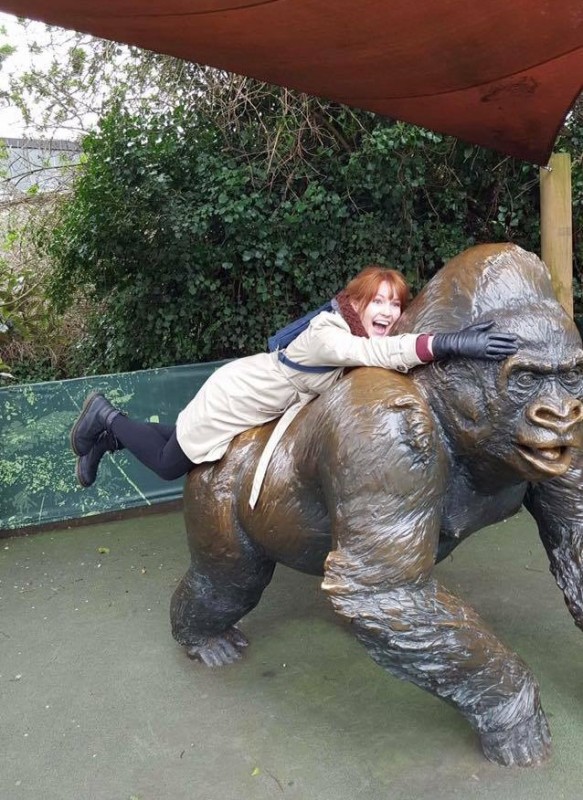Just Keep Swimming!
-Dory, “Finding Nemo” (2003)

Picture this: You’re sitting in a well-lit, white room. It is large, about the size of a high school classroom. The windows are large bay windows that open inward and let in a lot of light, but there are also florescent lights on the ceiling. the floor is a grey, smooth, plastic dance floor. Backpacks, coats, shoes, and chairs are stacked to one corner near the door. You’re a college drama student, and you’re sitting crosslegged on the floor. In front of you, eight of your fellow students strut about, pretending to be various zoo animals (complete with sound effects). You think…
This.
Is.
Amazing.
SO, there you go! That’s what I did yesterday, how about you? … Okay, before my parents catch on and stop funding my education, let me explain WHY we were acting like animals. I mentioned in earlier posts how PHYSICAL this program at LDA is: how we have Movement, Physical Theatre, Acting, Stage Combat, and Stretch Yoga on top of all our other classes. It turns out, performance is a pretty PHYSICAL, bodily endeavor. It’s not just about voices and facial expression; every move you make and your relation to space and others in the space tells a story. A line of men at the front of the room staring at the audience means something completely different than that same line at the back of the room facing away. How are you able to tell a young woman’s walk from an old man’s? Or a timid person versus a relaxed, comfortable person? Ursula said it best, people- “Body language!!!”
So, in Physical Theatre, I learned about the neutral mask and how the body has eight stages of tension. Each stage of tension communicates a different emotion and state of being for the character, and it also has the ability to affect the audience. When you’re watching a really suspenseful film and a woman is hiding, breathing shallowly, and has her eyes wide and darting, don’t you get a little anxious yourself? These stages of tension range from utter relaxation (amoeba) all the way to complete anxiety (catatonic). One can’t stay in catatonic long, or the terror is hard to break out of. (That’s how powerful body language can be!)
In Movement, which is my favorite and least favorite class all at once, my body is literally pushed to the limit. We find our body’s momentum and weight and learn to use it to move in and around space creatively in this class. I’m making it sound like a dance class, but in reality, we don’t learn routines, we MAKE them in the moment. One exercise we did today were these rolls across the floor that resembled somersaults, but we had to straighten our legs as they swung over our head so we could catch our momentum on our toes and slide back onto our tummies. It’s really hard to explain, but we do things like that-weird cartwheels, frogjumps, starfish rolls, handstands, and lots of creative jumps and turns across space. It’s really fun, but really frustrating at times when you want to keep working and just nail a move, but your body is just exhausted.
That brings us to the animal exercise! OKAY, so in Acting, we were broken into groups and assigned plays and characters that we’ll be playing for the midterm presentation. I got Top Girls, by Caryl Churchill, and my character’s name is Patient Griselda. (I’m not going to bother trying to explain Churchill’s complicated structure, but it’s quite a read so I recommend it!) Anyway, we learned that each character has a specific plane and pattern of movement that endures through the scene. The specific term for what we did was Laban Movement Analysis; it’s this way of annotating and recording dances and ballets, but it works for actors as we try to understand our characters! My character has a sort of gliding movement pattern, she’s light, flexible and sustained in her personality and her actions. Our teacher, Kathryn Pogson, told us that a great way to see exaggerated examples of these Movement forms was to head over to the London Zoo and find an animal that exhibited these traits. And YES, OF COURSE we all acted out the animal movements right in front of the enclosures so that EVERYONE around knew how crazy acting students are. But it really did help!! It’s amazing! I found a White-Naped Mangabey Monkey who reminded me so much of Griselda, and upon acting like the monkey in class, I feel like I got a better sense of the way Griselda carries herself! (And let’s be real, it was super fun to crouch and flit about like a monkey all day.)
So, before you go make any assumptions about how weird acting school is, remember that all this insanity is for a purpose! My sore biceps and hyper-awareness of posture will lend to character building and performance. It’s only week four, but I can already see how each of these classes are lending important tools to my actor toolbelt. I’m dead-tired and incredibly sore, but I see and feel myself getting stronger and stronger each class. I’m confident that by the end of this, I’ll be eager to get onstage and show you all what I’ve learned…right after I’ve taken a four month nap!
Cheers!
Taylor